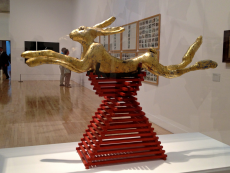
Email: emanuelealbertocirello.98@gmail.com
Total Article : 76
About Me:I am a Year 13 student which aspires to be an architect. I am interested in anything I don't yet know, and I mostly write about art, politics , Italian culture and inspirational people, although I will try to write for as many categories possible, just to test myself and get to know more things.

The sculpture “Leaping Hare” by Barry Flanagan is a combination of fluidity, found in the very natural and immediate movement of the animal, and stasis, found at the very geometrical composition of the base at the bottom on which the bronze statue lies.
The sculpture, "Leaping Hare (embellished)", 2/3 jan ’80 198 0portrays an outstretched hare that has firstly been modelled in gesso and then gilded in bronze, layibg on top of a plinth made from a lattice of red-painted wood. It was Flanagan’s final work in the exhibition of stone sculptures at Waddington Galleries, London in 1980 and immediately signaled a shift in the direction that his work would later take.
The sculpture of the hare is not purely animalistic, as it has human like attributes mainly in its movement and prolonged shape. Such human like characteristics could however be interpreted also as an abstract combination which makes the hare in the sculpture an animal unique to its type. The movement of the hare is very fluid and the extension of it seems very natural although the dimensions of the animal’s body do not seem very realistic.The hare is a subject that starting from this work has dominated Flanagan’s work for the best of thirty years in his career, repeatedly returning to it in his bronze sculpture. The figure of the hare is for the artist an archetypal embodiment of the trickster, delighting in breaking rules.
The static and firm base, which supports the sculpture, is a composition made by the intersection of wooden sticks. The stand is composed by two main prisms: a pyramid and a cuboid on which the hare lies.
The aesthetics of the overall sculpture is a mix of both good and bad attributes. The body of the hare, which is shiny and visibly attractive is contraposed to a dark and dull base, which creates a very firm contrast between the fluidity of the hare’s motion and the stasis of the base. The almost heroic look of the animal is also related to the material used, as bronze was considered as a very aristocratic material for art in previous centuries, and therefore the artist as made an ironic link to this knowledge.
Considering the dimensions of the sculpture ( 67.9 cm x 69.5 cm x 17 cm), the artist has used bronze as a main material for its very high tensile strength which ensures the stability of the bronze’s body, and also because of its malleability which has made it easy to produce the very large body. The use of bronze has also ensured the durability of the sculpture and has improved its look as bronze is a material that catches and exploits light to expose the detailed surface of the sculpture.
The wooden stand is the complete opposite. It is significantly darker than the hare’s body and it looks a lot less heroic and elegant. The artist has used wood as a material to its stand because it is a cheap material that can be quite easily assembled, and has the primitive and rustic look which the hare should have instead.
Image credits: https://www.flickr.com/photos/sequinsandcherryblossom/9152198045

0 Comment:
Be the first one to comment on this article.